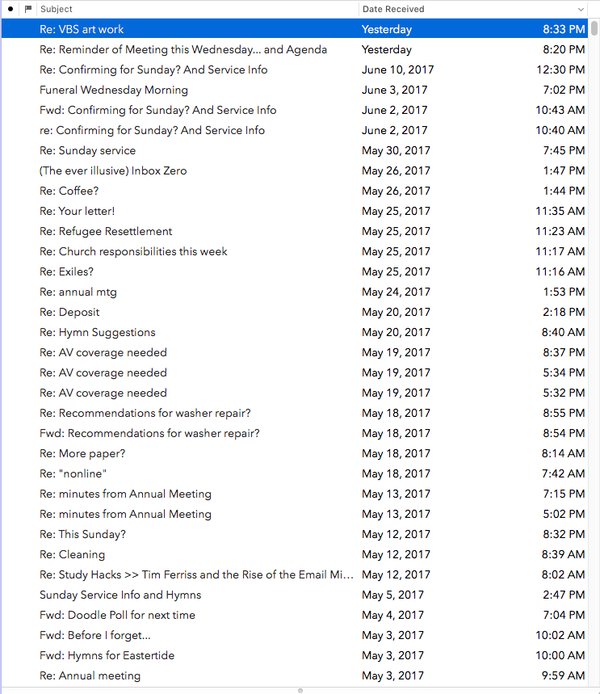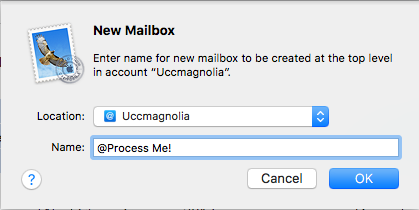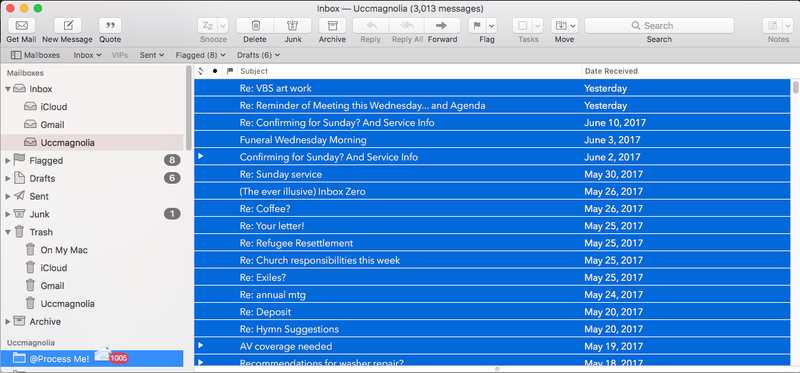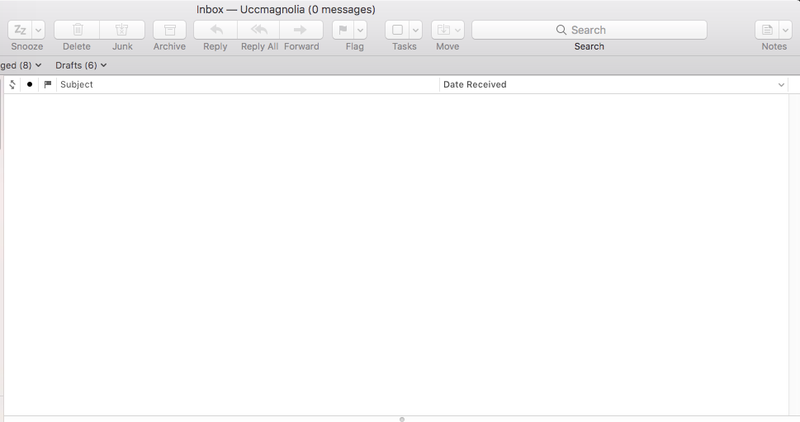A ministry supervisor once told me a quick way to lose respect in ministry: Don’t return people’s phone calls. The same holds true for email.
While we shouldn’t feel enslaved to desktop or smartphone notifications, responding to email is an under-appreciated aspect of pastoral ministry. Our inboxes hold messages ranging from prayer requests and sermon feedback to meeting agendas and conversations with the Buildings and Grounds Committee about which paper towel solution the church should use in the restrooms. Whatever the topic, your congregation needs to know their pastor will respond.
Just as a cluttered desk inhibits concentration, an unprocessed inbox takes up mental space. A clear inbox, by contrast, increases flexibility and allows me to respond to needs as they arise.
Reset to Inbox Zero in two minutes.
I once read about an executive who declared “email bankruptcy.” He deleted all of his emails and set up an auto-reply message to tell his contacts about his Chapter 11 status. If they wanted a reply to a previous query, they’d have to write a new email or re-send the old one.
Only an exec could pull this off. A middle manager doesn’t have the workplace capital to declare email bankruptcy without repercussions. I’m not sure a pastor does, either.
What can the rest of us do when the inbox creeps past 50, 100, or 3,000 emails?
Does this look familiar?
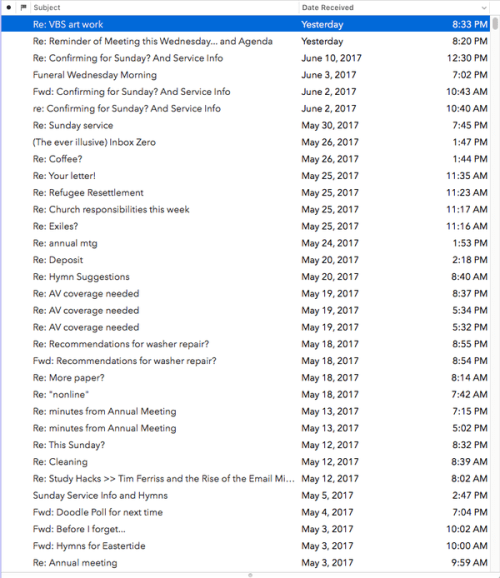
Against a backdrop of other priorities and tasks, processing that electronic pile—which could include items relevant to any of the 15 categories of your job description—can feel insurmountable. Here’s a trick for clearing everything out for a fresh start, without declaring email bankruptcy.
Create a new folder to show up beneath your inbox. You can name it anything, but precede the name with a non-alphanumeric character to move it to the top of an alphabetized folder list. (You can also drag your new folder to the top of the list.) I created a folder called “@Process Me!”
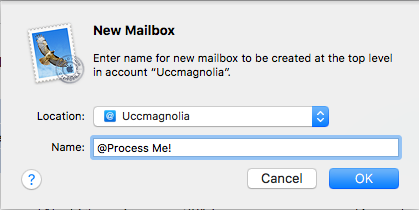
Now for the satisfying part: select all your inbox messages and move them to the new folder.
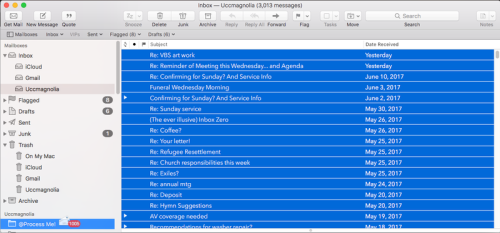
Voilà! You’ve reached Inbox Zero. Your inbox is a clean slate.
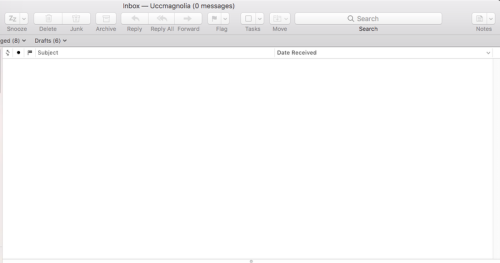
You didn’t process any of those messages, of course—they’re still in “@Process Me!” awaiting your attention.
But now your inbox (and your head) is clear, and you can immediately start following good practices for staying at Inbox Zero.
Here’s the key to justifying what otherwise would be merely psychological: set a recurring reminder (in a task management app or in your day planner) to process your “@Process Me!” a couple times a week. Now “@Process Me!” can stay out of sight until you’re ready to whittle down the folder.
Maintain Inbox Shalom.
Congratulations! You’re at Inbox Zero. How do you stay there? Here are three ways to maintain Inbox Shalom.
1. Understand what email is.
2. Turn off email notifications.
3. Limit how much you check your email.
1. Understand what email is.
You’ve probably heard the OHIO rule for paperwork: Only Handle It Once. Moving papers from your desk to the top of a bookshelf is not progress if you’ll pick up the same papers again later. OHIO means that a youth permission form or retreat center invitation or bill all have the same fate: you take action on them, you file them for reference, or you get them out of your airspace—either into the recycling or passed on to the appropriate party.
OHIO applies to email, too. How many times have you looked at the same 200 messages in your inbox? After a while you start to gloss over them, but if they’re still there, presumably it’s because you need to close the loop on each message or access the information therein.
But an inbox is meant to be a temporary space—like the mailbox outside your house. Empty it out regularly.
How? Handle each message only once.
Perhaps the main reason we don’t apply OHIO to email is that we’re not sure what to do with a given message. We might even reply but not want to lose the information in the exchange, and since we have no established system, the email remains in the inbox indefinitely, leading to clutter. An inbox with 5,000 emails is easily searchable when we need information, but better to set up and rely on a system that takes the inbox out of the mix completely, so it can remain clear.
Many emails are tasks, notes to be filed, or calendar appointments in disguise. Gmail and Outlook don’t differentiate—your messages all come to the same place. We’ll have a better shot at Inbox Shalom if we understand that there is a range of potential actions to take on email:
- reply
- add to a task list
- set up an appointment
- file the email’s contents for future reference
- read and delete
- unsubscribe
Many emails require a reply and another action—agree to an appointment, delete the message, and record the meeting in your calendar.
Appointments are obvious enough, but how many of us keep a running list of tasks in our email inbox? Many email clients allow you to automate the process of turning a message into a task in your app of choice. Do it and delete the email, knowing your reminder will pop up later in your task management app. Or if you track tasks on paper, write down the action that an email message calls for, and delete the email.
Some emails are not actionable—they are not tasks or appointments, or you have already replied but want to keep a record of the decision the Finance Committee just made. Whether you use email folders, labels, or a note-storing system like Evernote, save the contents of email messages or the messages themselves—just put them anywhere but in your inbox.
2. Turn off email notifications.
I’ll never forget the epiphany and sense of relief I had when reading Kevin Miller’s Surviving Information Overload: you can turn off your email notifications. Who knew? My email program does not always have to make a sound or flash a notification across the screen every time a new message comes in. Most email apps allow you to do any or all of the following:
- adjust how frequently you receive your messages
- turn off the visual notification and sound that accompanies each new incoming message
- close the email program altogether
Not only is checking email mid-project a distraction for the time it takes to read and process the email; it takes additional time after interacting with that message to get re-focused on the initial task at hand. You don’t need to respond right now to emails about next spring’s confirmation class when you’re working on this Sunday’s sermon.
Email can wait. If it’s so urgent you have to act on it now, you’ll get a phone call or text message. Miller describes his realization this way: “Some emails required a quick reply, but for none would a delay jeopardize national security.” When you’re ready to check email, open the program and your messages will be there.
3. Limit how much you check your email.
Miller suggests opening your email program during off-peak moments (right after lunch, for example). Productivity guru Julie Morgenstern wrote a book called Never Check E-Mail in the Morning. That was important advice when she wrote it in 2004, and it’s even more so now. Spend early morning hours tackling more difficult tasks, or projects like sermon writing that require longer periods of focus. And before you go to your device, have ready at least a three-item list of priorities for the day.
Limiting how often you check email keeps you out of reactive mode. Checking email twice daily is plenty. (I’m preaching to myself here, too!) The recipients of your electronic missives will adjust. Within 24 hours is an appropriate response time. But if you consistently reply to every email you receive within two or three days of receipt, as long as you write back, your readers will adjust expectations.
Know when email is not the right medium.
In pastoral ministry we’ll inevitably receive emails detailing anything from a relational conflict to a list of perceived deficiencies in the church. But email is not always the best medium for those conversations. I remember relational challenges from my early ministry days that I spent hours trying to resolve over email.
Usually, it makes sense to reply to a query via the medium that brought it in, whether an in-person conversation, a phone call, or an email. But email as a medium is not equal to the task of relational problem solving. (I’ve learned this the hard way.) Voice-to-voice or face-to-face interaction is required, even if the sender of email is still thinking in terms of 1s and 0s. Take the conversation off email. An appropriate response is, “Thanks for sharing your concerns. I take these seriously and want to respond. Are you available to chat by phone this afternoon?” Or you could just call.
For difficult conversations, the more dimensions you have available to you (three as opposed to two, and the opportunity to read body language and tone), the better. Don’t over-rely on email, and don’t expect it to help you move toward resolution that requires a face-to-face conversation.
A clear email inbox is a ministry aid. If you’re feeling overwhelmed, clear out your inbox right now and move everything into a new “@FreedomFromInboxTyranny” folder. Adjust your settings and experiment with not checking email for hours at a time. You’ll love it, eventually! Make sure you have systems beyond your inbox in place so you can easily put each email message (which might be a calendar appointment or task in disguise) in its right place.
Here’s to a greater sense of Inbox Shalom!
Abram Kielsmeier-Jones is pastor of Union Congregational Church in Magnolia, Massachusetts.


